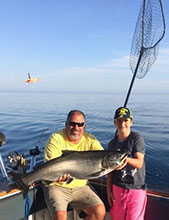(Provided by Michigan DNR)
 Michigan DNR Predicts Better Salmon Fishing AheadLake Michigan has had a tough couple of years, especially as it relates to fishing for salmon. After a few years with a low population, fishing really picked up this past spring. Anglers on the lake experienced limit catches of coho and Chinook salmon thanks to some improvement in the numbers of bait fish available.
Michigan DNR Predicts Better Salmon Fishing AheadLake Michigan has had a tough couple of years, especially as it relates to fishing for salmon. After a few years with a low population, fishing really picked up this past spring. Anglers on the lake experienced limit catches of coho and Chinook salmon thanks to some improvement in the numbers of bait fish available.
Lake Michigan has experienced some historic low bait levels in recent years due to harsh winter conditions, less available nutrients resulting from invasive quagga mussels, and over predation from salmon and trout. But Mother Nature, working as she normally does, provided more moderate temperatures the last couple of winters that have allowed bait fish like alewife, smelt, bloaters and lake herring to reproduce and survive.
"The 2015 and 2016 year classes of bait are much better than previous years," said the DNR's Lake Michigan Basin Coordinator Jay Wesley. "These bait fish are helping to support the improved salmon fishery this year."
Natural resources managers responsible for Lake Michigan have been aggressive to balance the number of predators in the lake. Recognizing both the recent low bait numbers and the increase in Chinook salmon and lake trout natural reproduction, professional managers have reduced the stocking of Chinook salmon, lake trout and brown trout throughout the lake.
"There have been four significant lake-wide stocking reductions going back to 1999 to compensate for changing bait numbers and increased natural reproduction," Wesley shared. "These efforts appear to be paying off and have allowed the bait fish to rebound."
Invasive species like quagga mussels continue to disrupt the Lake Michigan food web and store valuable nutrients on the bottom of the lake. These nutrients are important to support good populations of algae and zooplankton that feed bait fish like alewife and bloaters and are also important in the early life of trout and salmon.
Overtime some fish have adapted to this new food web. Gobies will eat quagga mussels and have provided a new bait source for lake trout, steelhead, brown trout and some coho salmon. With this shift in diet, there is less predation pressure on alewife, smelt and bloaters.
"Cisco, a close relationship of the lake whitefish, are also adapting and these fish provide a source of prey to salmon during their first two years of life," said Wesley. "Although quagga mussel populations continue to grow in the deepest parts of Lake Michigan, their nearshore populations have declined providing more available nutrients in shallow waters that fish are able to utilize. Offshore and deep water areas continue to be nutrient deprived."
Despite these changes in the lake, anglers can expect to catch more coho and Chinook salmon in 2017 along with a mix of steelhead, lake trout and brown trout. Coho salmon continue to be caught up and down Lake Michigan's coast and should approach eight to ten pounds by this fall. The Chinook salmon population is made up of younger age one and two-year-old fish that should be four to 12 pounds this year. There is still some age three and four Chinook salmon out there that should tip the scales at 20 to 30 pounds.
"As the summer progresses, anglers should target thermoclines in the lake where water temperatures are 55 degrees or less often in 100 feet of water or deeper with lures set 40 to 70 feet down," explained Wesley. "Trout and salmon will move nearshore during east wind events providing pier fishing opportunities. In August through late September, salmon will be available along shore and near river mouths for great small boat and pier opportunities. Casting spoons or using live alewife are good options for the pier, and trolling spoons and plugs are best for boat anglers working 30 to 50 feet of water and river mouths."
For more information on when and where to experience good salmon fishing, check out the "Road Map to Fishing Lake Michigan" at Michigan.gov/fishing.





